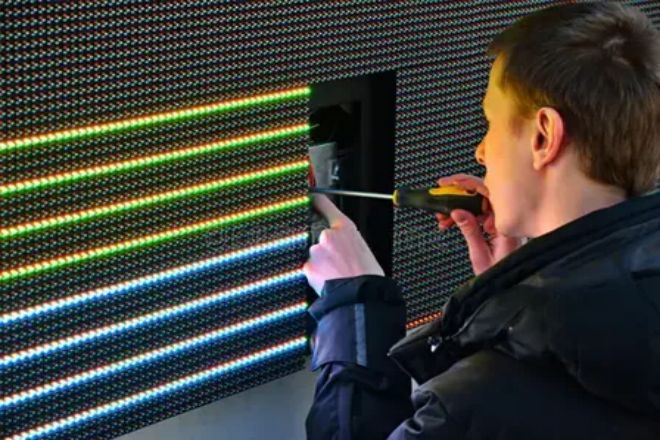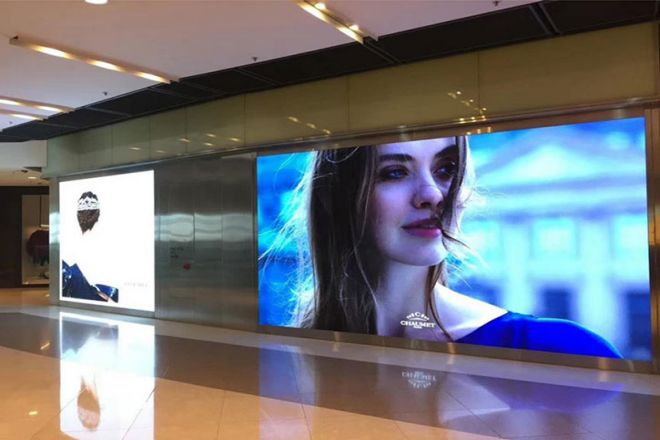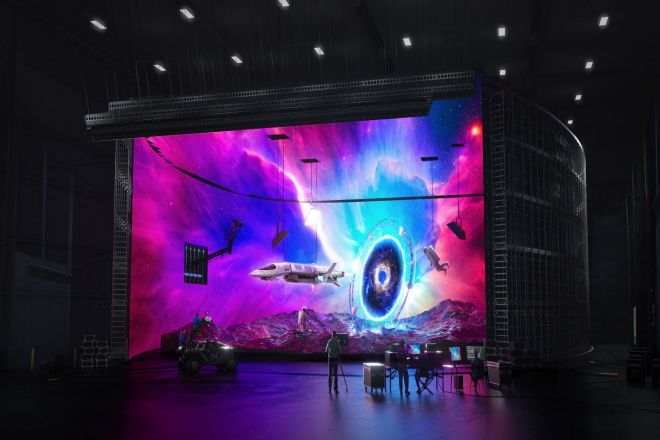Introduction

LED display screens, with their high brightness, high contrast, and bright colors, have become an indispensable information display tool in modern life. Whether it is shopping mall advertising, outdoor promotion, sports venues, conferences, or exhibitions, LED displays play an important role.
However, with its widespread application, signal interference problems have become increasingly prominent, posing considerable challenges to the normal operation of the display and the accurate transmission of information.
This article will focus on the signal interference problem of LED display screens, analyze the causes of interference, and introduce a series of practical solutions. Let’s take a look together.
1. The performance and harm of LED display screens being affected by signal interference
When the LED display screen is interfered with by signals, it may display a variety of behaviors, including but not limited to:
Flashpoint, flicker: This is the most common manifestation of signal interference. When horizontal and vertical lines flash on the display, it may be caused by the clock frequency (DLCK) being too high. Because clock and data are relatively high frequencies in the control system, they are more susceptible to interference. Properly reducing the frequency of DLCK and adjusting the phase and duty cycle can reduce interference.
Multi-line ripples: When the display screen is interfered with by static electricity, multi-line ripples may appear on the display.
Interference from several vertical bars with equal spacing: This is usually a fault phenomenon caused by a mismatch in the characteristic impedance of the network cable.
The hazards of LED display screens affected by signal interference are mainly reflected in the following aspects:
Affecting the display effect: Signal interference will cause the display effect of the LED display to decrease, such as flickering, ripples, vertical bars, and other abnormal phenomena, which will affect the audience’s viewing experience.
Reduced service life: Long-term signal interference may cause damage to the hardware of the LED display, such as burning the driver chip, damaging the display, etc., thereby shortening the service life of the display.
Safety hazards: In some cases, signal interference may cause the control system of the LED display to malfunction, such as power short circuits, overheating, etc., resulting in fire and other safety hazards.
In order to prevent the LED display screen from being interfered by signals, the following measures can be taken:
Ensure that the electromagnetic radiation in the environment around the display is low, and avoid being close to sources of strong electromagnetic fields.
Use appropriate signal shielding measures, such as using magnetic rings, filters, etc.
Check and replace video network cables with poor quality to avoid core wire short circuits, open circuits, and other problems.
Keep the display’s cooling system running normally to avoid malfunctions caused by overheating.
Regularly check and adjust the parameter settings of the receiving card to ensure system support and normal operation.
2. Analysis of the causes of LED display signal interference

The reasons for LED display signal interference can indeed be attributed to many aspects. The following is a detailed analysis of several main reasons you mentioned:
1). External electromagnetic environment interference:
Radio waves: Radio waves existing in the surrounding environment, such as wireless communications, radar, etc., may conflict with the working frequency of the LED display, thereby interfering with the normal operation of the display.
Lightning: The powerful electromagnetic pulse generated by lightning can cause great interference to electronic equipment and may even damage the equipment. Therefore, lightning protection measures should be considered when installing LED displays.
2). Internal circuit design issues:
Unreasonable power supply design: Unreasonable power supply design may cause power fluctuations, noise, and other problems that may interfere with the signal transmission and display of the LED display.
Improper signal transmission lines: The length, material, wiring method, etc., of the signal transmission lines may affect the signal transmission quality. If not designed properly, it may cause signal attenuation, distortion, and other problems.
3). Equipment is aging or damaged:
Aging of the display driver board: The driver board is an important part of the LED display and is responsible for controlling the on and off of the pixels. If the driver board is aged, it may cause unstable signal transmission, thus affecting the display effect.
Damage to the connecting wire: The connecting wire is the link that connects the various components of the display. If the connecting wire is damaged or has poor contact, it will cause signal transmission to be interrupted or unstable, thereby interfering with the normal operation of the display.
4). Poor installation environment:
Improper installation location of the display: If the LED display is installed in a location prone to external interference, such as near high-voltage lines, wireless communication base stations, etc., it will be more susceptible to interference.
Ambient temperature, humidity, and other factors: Too high or too low temperature and humidity may affect the normal operation of the LED display, thereby causing signal interference.
In addition, there are some other factors that may also cause the LED display to be subject to signal interference, such as:
The distance between the power line and the signal line is too close: The electromagnetic field generated by the power line may interfere with the transmission of the signal line.
The internal circuit layout of the display screen is unreasonable: If the internal circuit layout of the display screen is too dense or messy, it will easily lead to electromagnetic interference between the circuits.
Static electricity interference: Static electricity may cause damage to the LED display, especially in dry environments.
For these reasons, corresponding measures can be taken to reduce or eliminate signal interference from LED displays, such as optimizing circuit design, strengthening equipment maintenance, and improving the installation environment.
3. Practical methods to solve the signal interference of LED display screen
For the problem of LED display signal interference, the following are some practical solutions:
- Optimize the external environment:
Reduce the surrounding sources of radio wave interference as much as possible, such as avoiding placing radio transmitting equipment near the display screen to reduce interference signals.
Install lightning protection facilities, such as lightning rods and lightning protection nets, near the display to reduce interference and damage to the display caused by lightning.
- Improve internal circuit design:
Arrange the power lines rationally to ensure a certain distance between the power lines and signal lines to reduce electromagnetic interference.
Optimize signal transmission methods, such as using differential signal transmission, adding data error correction codes, and other technologies to improve the reliability of data transmission.
In PCB design, pay attention to the fact that the ground circuits of high-frequency digital circuits and low-level analog circuits cannot be mixed to reduce ground interference.
- Regular inspection and maintenance:
Regularly check the display’s power supply, control card, connecting cables, and other components to ensure they are in good working order.
Aged or damaged parts should be replaced in time to ensure the stable operation of the display.
Perform regular maintenance on the display, such as cleaning the display surface and checking whether the connecting cables and components are aging, etc.
- Improve the installation environment:
Choose a suitable installation location and avoid installing the display in a place prone to external interference, such as near high-voltage lines, wireless communication base stations, etc.
Make sure the display is well-ventilated to avoid overheating, and use a heating device to keep the display at normal operating temperature in cold environments.
If possible, anti-interference measures such as shielding technology and filtering technology can be adopted, such as using metal shields and adding filters and other equipment, to reduce the impact of external interference signals on the display effect.
4. Prevention and daily maintenance suggestions

For the prevention and daily maintenance of LED displays, the following are some suggestions:
- Establish a regular maintenance system:
Set a fixed maintenance cycle, such as a monthly or quarterly comprehensive inspection, to ensure that the display hardware and software are in good condition.
During the maintenance process, you should focus on key components such as the display’s power supply, control system, cooling system, and connecting lines to ensure that they are working properly.
Clean the display to remove dust and dirt to improve display and cooling performance.
- Raise awareness of usage:
Train operators to use and maintain the display screen correctly, including the correct power on and off sequence, avoiding all-white, all-red, all-green, and other bright screens for long periods of time.
Emphasize the environmental requirements for the use of the display screen. Avoid use or storage in high temperature, high humidity, and high acid/alkali/salt environments, and keep away from flammable items, gases, dust, etc.
Operators are reminded to pay attention to the heat dissipation of the display and avoid prolonged use under poor heat dissipation conditions.
- Enhance technical updates:
Pay attention to the development trends of LED display technology and understand new hardware and software technologies so that the display can be upgraded and optimized in a timely manner.
Regularly check and update the display’s control system and software to ensure they are the latest versions and to fix known software vulnerabilities or issues.
Introduce advanced maintenance tools and technologies to improve maintenance efficiency and effectiveness, such as using remote monitoring and diagnostic tools to monitor the operating status of the display in real-time.
By establishing a regular maintenance system, improving usage awareness, and strengthening technology updates, we can ensure that the LED display screen is in good working condition for a long time, improve the display effect and stability, and extend the service life. At the same time, it helps detect and solve potential problems in a timely manner to avoid failures that may affect normal operations.
Conclusion
To sum up, solving the signal interference problem of LED display screens is a systematic project that requires us to start from multiple aspects and take comprehensive measures. Through the introduction and discussion of this article, I hope to provide you with useful references and references to promote the sustainable development and application of LED display technology.
If you want to know more about LED displays, please get in touch with us.

One Response
Hola cómo están? Mira estoy teniendo problemas con la pantalla led y no. Encuentro no encuentran soluciones los técnicos. Dejan de funcionar paneles o largan interferencia. En un momento pensamos que se quemaban las placas pero no es así. Gracias y aguardo respuesta o podría talvez telefonicamente comunicarme con ustedes.